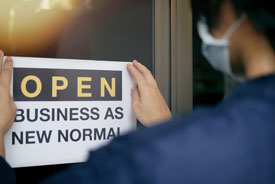 It’s optimistic to believe that we are now seeing COVID-19 in the rear-view mirror and we don’t know how long the Coronavirus will continue to affect businesses and what pandemic survival strategies are here to stay.
It’s optimistic to believe that we are now seeing COVID-19 in the rear-view mirror and we don’t know how long the Coronavirus will continue to affect businesses and what pandemic survival strategies are here to stay.
The return to “normal” will be gradual and should include a return-to-work plan for employees to keep everyone healthy and safe during the uncertain post-COVID period. Both employer and employees benefit from return-to-work plans as they provide structure and specify expectations. They can also increase employee engagement and loyalty, as employees will feel supported by the company and secure in their role.
A Back-to-Work plan should include CDC guidelines, as well as any industry recommendations. Your plan should address the gradual return to work for employees who have been working from home, on leave, or were ill.
Return-to-Work Plans should include:
- Anticipated return to work date with flexibility and adherence to local and state COVID-19 guidelines
- Disinfecting and cleaning measures to delineate the frequency and responsibilities for cleaning office equipment, workstations, phones, etc., and the location of supplies in order to comply with these measures.
- Social Distancing Protocol to avoid spreading illness, which may include spacing of workstations, avoidance of gatherings of 10 or more people, virtual meetings, and discouraging people from shaking hands.
- Screening Procedures may include taking employee temperatures and requiring employees who feel ill to stay at home and work virtually, if possible.
- Managing Mental Health and Employee Requests. Stress levels have risen, and employees may have special needs to manage their mental health or family issues that may require requests for flexibility in their workweek.
Alterations in the Workplace
If employees were asked to work from home during the last year, they may ask to continue to do so. Your company will need to decide if it can be flexible in this regard and perhaps come to a compromise to meet these demands amicably.
The office layout may also need to be changed to add social distancing. You will need to provide adequate supplies and have them readily available for employees and customers. Items such as hand sanitizer, anti-bacterial wipes, tissues will need to be provided.
A Disturbing Change
The kinks in the supply chain have created a slow-down and sometimes substantial delays in getting parts or supplies for manufacturing. This has meant that businesses may no longer be able to promise shipment and delivery times as they did pre-COVID. These delays have had a domino effect and the repercussions have been felt by many industries. If you usually wait to reorder an item you need until you are down to a one- or two-month supply, you need to change the process to order now even if you have a more than adequate supply on hand. Depending on your industry, these delays can be sporadic or everyday occurrences.
Pandemic Strategies That May Live On
Aside from the issue of working virtually and whether it has merit for you as your business resumes, there are strategies that businesses used to survive the past year and may continue to do so even as we return to “normal.”
Online Services
Retail businesses expanded their service offerings via the Internet long before COVID-19 made that necessary. But who would have predicted that telehealth would become an everyday occurrence with virtual doctor consultations? Realtors offered extensive online tours of homes to substitute for in-person visits. An online presence for many businesses made the difference between weathering the storm and closing permanently. If you are not online yet, you should consider it, as this marketing tool allows you to reach new customers outside of your geographic location and to develop new and innovative revenue streams.
Communication is Key
All during COVID-19 businesses have stepped up their communication activities with clients, customers, and prospects. If haven’t been in touch with your base, you need to do this now or risk them finding another vendor for your products and/or services. Send emails, contact your clients by phone, send them oversized postcards to let them know you are back (or still) in business, ready to assist them with their needs.
One thing is sure about the Pandemic and that is that nothing is really clear or steadfast. The science changes because we are learning more and more about the Coronavirus as time goes on. Hopefully, with more and more people vaccinated, businesses will be able to get back to normal sooner and with great success.
If you want to discuss creating a strategic marketing plan for your company in the post-COVID-19 period and beyond, call Noel Choquette at 978-505-2783 or send him an email.
